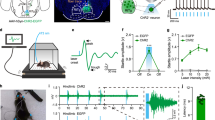Summary
-
1.
The Mauthner (M-) cell triggers a complex startle or escape movement when the zebrafish,Brachydanio rerio, is presented with a sudden vibrational stimulus. Alternative (non-Mauthner) circuits functionally substitute for the M-cell to produce similar behavior patterns when the M-cell is missing or fails to fire. These responses are called non-Mauthner responses. In this paper, we demonstrate that vibrational stimulation of the tail reliably elicits responses initiated by non-Mauthner circuits in animals with intact M-cells. We conclude that such non-Mauthner circuits can functionally substitute for the M-cell in generating the escape response.
-
2.
To characterize sensory pathways responsible for activating the Mauthner and non-Mauthner responses in intact animals, we made detailed comparisons of response thresholds and latencies to vibrational stimuli applied to the head and the tail.
-
3.
In a comparison of vibrational stimulation applied to the head versus the tail, the M-cell was more sensitive to vibrational stimuli applied to the head. In pairwise comparisons the M-cell had the lowest threshold to the head stimulus in about 62% of the trials and the shortest latency in 79% of the trials (Table 1). For responses initiated by non-Mauthner cells, there was no difference in threshold to head and tail stimuli, but shorter latencies occurred when the head was stimulated than when the tail was stimulated (Table 1).
-
4.
In a comparison of Mauthner and non-Mauthner responses, we found that in 77% of the trials, Mauthner responses occurred at lower stimulus intensities than the responses initiated by non-Mauthner circuits when a vibrational stimulus was applied to the head. But, when the tail was stimulated, there was no apparent difference in stimulus intensity required to elicit Mauthner responses and responses initiated by non-Mauthner circuits. The Mauthner responses were always substantially shorter in latency (by an average of 15 or 21 ms) than the responses initiated by non-Mauthner circuits when stimulating either the head or tail.
-
5.
We conclude that at least two sensory systems are involved in the activation of these startle systems when stimulating the head and tail of the zebrafish. One system is the otolithic receptors of the ear and another is probably either the posterior lateral line or Rohon-Beard cell system. The findings are discussed in terms of a general model that provides a mechanism for functional substitution of responses initiated by non-Mauthner circuits for Mauthner responses.
Similar content being viewed by others
Abbreviations
- M :
-
Mauthner
References
Eaton RC (1983) Is the Mauthner cell a vertebrate command neuron? A neuroethological perspective on an evolving concept. In: Ewert JP, Capranica RR, Ingle DG (eds) Advances in vertebrate neuroethology. Plenum Press, New York, pp 629–636
Eaton RC, Farley RD (1975) Mauthner neuron field potential in newly hatched larvae of the zebrafish. J Neurophysiol 38:502–512
Eaton RC, Hackett JT (1984) The role of the Mauthner cell in fast-starts involving escape in teleost fishes. In: Eaton RC (ed) Neural mechanisms of startle behavior. Plenum Press, New York, pp 213–266
Eaton RC, Kimmel CB (1980) Directional sensitivity of the Mauthner cell system to vibrational stimulation in zebrafish larvae. J Comp Physiol 140:337–342
Eaton RC, Nissanov J (1984) A review of Mauthner-initiated escape behavior and its possible role in hatching in the developing zebrafish,Brachydanio rerio. Env Biol Fishes (in press)
Eaton RC, Farley RD, Kimmel CB, Schabtach E (1977) Functional development in the Mauthner cell system of embryos and larvae of the zebra fish. J Neurobiol 8:151–172
Eaton RC, Kimmel CB, Sessions SK (1978) The Mauthner system mediates directional responses to local vibrational stimuli. Soc Neurosci Abstr 4:361
Eaton RC, Lavender WA, Wieland CM (1981) Identification of Mauthner-initiated response patterns in goldfish: Evidence from simultaneous cinematography and electrophysiology. J Comp Physiol 144:521–531
Eaton RC, Lavender WA, Wieland CM (1982) Alternative neural pathways initiate fast-start responses following lesions of the Mauthner neuron in goldfish. J Comp Physiol 145:485–496
Kimmel CB, Eaton RC, Powell SL (1980) Decreased fast-start performance of zebrafish larvae lacking Mauthner neurons. J Comp Physiol 140:343–350
Kimmel CB, Sessions SK, Kimmel RJ (1981) Morphogenesis and synaptogenesis of the zebrafish Mauthner neuron. J Comp Neurol 198:101–120
Kimmel CB, Powell SL, Metcalfe WK (1982) Brain neurons which project to the spinal cord in young larvae of the zebrafish. J Comp Neurol 205:112–127
Krasne FB, Wine JJ (1984) The production of crayfish tailflip escape responses. In: Eaton RC (ed) Neural mechanisms of startle behavior. Plenum Press, New York, pp 179–211
Laurence S, Stein DG (1978) Recovery after brain damage and the concept of localization of function. In: Finger S (ed) Recovery from brain damage. Plenum Press, New York, pp 369–407
Nissanov J, Eaton RC, Wieland CM (1984) A role for non-Mauthner escape circuits in larval zebrafish: Implications for functional substitution in lesioned and normal animals. Soc Neurosci Abstr 10:402
Prugh JIP, Kimmel CB, Metcalfe WK (1982) Noninvasive recording of the Mauthner neurone action potential in larval zebrafish. J Exp Biol 101:83–92
Reichert H, Wine JJ (1983) Coordination of lateral giant and non-giant systems in crayfish escape behavior. J Comp Physiol 153:3–15
Ritzmann, RE (1981) Motor responses to paired stimulation of giant interneurons in the cockroachPeriplaneta americana. J Comp Physiol 143:71–80
Roberts A, Hayes BP (1977) The anatomy and function of ‘free’ nerve endings in an amphibian skin sensory system. Proc R Soc Lond B 192:111–127
Webb PW (1981) Responses of northern anchovy,Engraulis mordax, larvae to predation by biting planktivore,Amphiprion percula. Fish Bull US 79:727–735
Wieland CM, Eaton RC (1983) An electronic cine camera system for the automatic collection and analysis of high-speed movement of unrestrained animals. Behav Res Methods Inst 15:437–440
Wieland CM, Eaton RC (1984) Evidence for Mauthner-derived inhibition of non-Mauthner escape responses in goldfish. Soc Neurosci Abstr 10:402
Author information
Authors and Affiliations
Rights and permissions
About this article
Cite this article
Eaton, R.C., Nissanov, J. & Wieland, C.M. Differential activation of Mauthner and non-Mauthner startle circuits in the zebrafish: Implications for functional substitution. J. Comp. Physiol. 155, 813–820 (1984). https://doi.org/10.1007/BF00611598
Accepted:
Issue Date:
DOI: https://doi.org/10.1007/BF00611598




